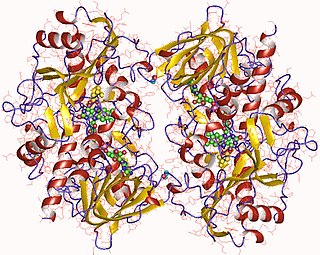| Aldehyde dehydrogenase (FAD-independent) | |||||||||
|---|---|---|---|---|---|---|---|---|---|
| Identifiers | |||||||||
| EC no. | 1.2.99.7 | ||||||||
| Databases | |||||||||
| IntEnz | IntEnz view | ||||||||
| BRENDA | BRENDA entry | ||||||||
| ExPASy | NiceZyme view | ||||||||
| KEGG | KEGG entry | ||||||||
| MetaCyc | metabolic pathway | ||||||||
| PRIAM | profile | ||||||||
| PDB structures | RCSB PDB PDBe PDBsum | ||||||||
| |||||||||
In enzymology, an aldehyde dehydrogenase (FAD-independent) (EC 1.2.99.7) is an enzyme that catalyzes the chemical reaction
- an aldehyde + H2O + acceptor a carboxylate + reduced acceptor
The 3 substrates of this enzyme are aldehyde, H2O, and acceptor, whereas its two products are carboxylate and reduced acceptor.
This enzyme belongs to the family of oxidoreductases, specifically those acting on the aldehyde or oxo group of donor with other acceptors. The systematic name of this enzyme class is aldehyde:acceptor oxidoreductase (FAD-independent). Other names in common use include aldehyde oxidase, aldehyde oxidoreductase, Mop, and AORDd.





